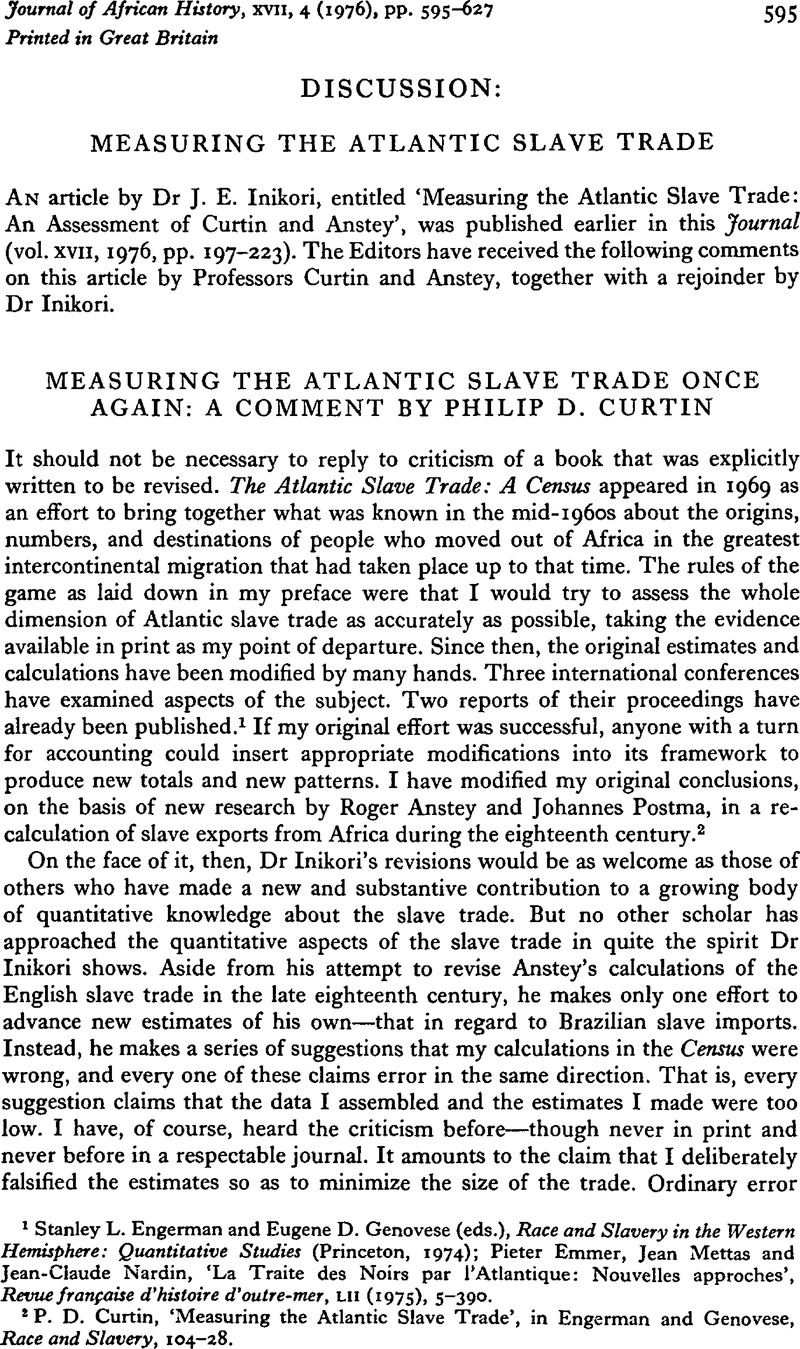Article contents
Measuring the Atlantic Slave Trade
Published online by Cambridge University Press: 22 January 2009
Abstract

- Type
- Discussion
- Information
- Copyright
- Copyright © Cambridge University Press 1976
References
1 Engerman, Stanley L. and Genovese, Eugene D. (eds.), Race and Slavery in the Western Hemisphere: Quantitative Studies (Princeton, 1974)Google Scholar; Emmer, Pieter, Mettas, Jean and Nardin, Jean-Claude, ‘La Traite des Noirs par l'Atlantique: Nouvelles approches’, Revue française d'histoire d'outre-mer, III (1975), 5–390.Google Scholar
2 Curtin, P. D., ‘Measuring the Atlantic Slave Trade’, in Engerman and Genovese, Race and Slavery, 104–28.Google Scholar
3 Anstey, Roger, ‘The Volume and Profitability of the British Slave Trade, 1761–1807’, in Engerman and Genovese, Race and Slavery, 3–31.Google Scholar
4 In mathematical terms, paraphrasing the Census, 32, where r equals the annual rate of growth, m the annual rate of immigration, and i the annual rate of natural increase or decrease, r = i+m.
If it is known that a population has increased in size from N0 to Nt in t years, then the average annual rate of growth, r, is given by:
Where the size of the population at the beginning and the end of the period of time is known, and where the rate of growth r, and the rate of immigration, m, are also known, the relationship simplifies to give the total number of immigrants, so that
Or, where T is known, but i or m is unknown:
5 The problem of tax-roll data is not Inikori's discovery but is well known to students of Caribbean demographic history. Inikori, however, missed G. W. Roberts' point in warning against the inaccuracy of these data, yet using them to measure relative change with an announced probability of error (Roberts, George W., The Population of Jamaica [Cambridge, 1957]. 34–8Google Scholar). See also Dunn, Richard S., ‘The Barbados Census of 1680: Profile of the Richest Colony in English America’, William and Mary Quarterly, xxvi (3rd series) (1969). 3–30, 7–10.Google Scholar
6 Médéric Louis Elie Moreau de Saint-Méry, Description topographique, physique, civile, politique et historique de la partie française de l'isle de Saint Dominigue, 2nd ed. 3 vols. (Paris, 1958), I, sGoogle Scholar; first published 1797.
7 His Table I, p. 203 contains a misprint which should read 1778–88, not 1778–89.
8 Peytraud, Louis, L'esclavage aux Antilles françaises avant 1789 (Paris, 1897), 139–40.Google Scholar
9 Roberts, , Population of Jamaica, 39–40Google Scholar. Inikori gives one more example of discrepancy between tax-roll data and estimates of the actual slave population in Governor Grenville's statement for Barbados as of 1748. The basis of Grenville's figure, however, is far from clear and the discrepancy of 45 per cent appears unreasonable. It is therefore set aside for present purposes. If it were used, however, it would have the effect of decreasing the estimated number of slaves imported even more than the combination of the other two will do.
10 These recalculations, like those on which Table 15 of the Census was based, follow the formula given above in note 4.
11 Inikori's census authority was Mannix, Daniel P., Black Cargoes: A History of the Atlantic Slave Trade 1518–1865 (New York, 1962), 54Google Scholar. (For some reason, Inikori omits the name of Malcolm Cowley, Mannix's co-author). The more accurate report is Alden, Dauril, ‘The Population of Brazil in the Late Eighteenth Century’, Hispanic-American Historical Review, XLIII (1963), 173–205.CrossRefGoogle Scholar
12 Gomes, A., ‘Achegas para a história do trafico africano no Brazil—Aspectos numericos’, IV Congresso de História National, 21–28 Abril de 1949 (Rio de Janeiro, 1950), 46, 65–66.Google Scholar
13 This literature is discussed in Census, 45–9.Google Scholar
14 Nardin, Jean-Claude, ‘Encore des chiffres: La traite négrière française pendant la première moitié du xviii siècle’, Revue française d'histoire d'outre-mer LVII (1970), 421–46.CrossRefGoogle Scholar
15 Daget, Serge, ‘L'abolition de la traite des noirs en France de 1814 à 1831’, Cahiers d'études africaines, xi (1971), 14–58.CrossRefGoogle Scholar
16 Le Page, Robert B., Jamaican Creole (London, 1960), 70–1.Google Scholar
- 13
- Cited by


